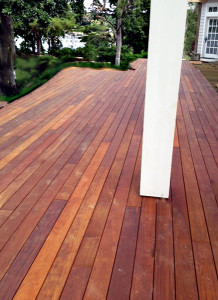
How much space to leave between deck boards? This is the most asked question about installing a deck. The easy answer is 1/4″ or about 6 mm. But that answer doesn’t take into account a lot of factors and can pose problems further down the road. The moisture content of the decking boards, how long they have had time to acclimate to your environment. How much sun the deck receives, how much rain, temperature swings throughout a day, ventilation beneath the deck, and so much more. All of these factors will effect the amount of space you put between your deck boards. Ever have a customer tell you the following when beginning a deck installation?
“I want no gap between the boards” or,
“I want a 1/4″ gap between my deck boards”
Your reply should be, “when?”
Like a stopped watch that is only right twice a day, those deck boards are going to expand and contract as the seasons change, and no matter what you do, the gap between the boards will only be consistent for a certain window of time. This is why you find so much debate on how to set the spacing between your decking, because the answer truthfully is, “it depends.”
The Seasons of Deck Board Spacing
The summer heatwave is in full effect across most of the country, and we continue to sell a lot of Ipe decking. It is a great irony that the bulk of deck building happens when the thermometer passes 90 degrees. The good news to this is that installing a deck during this weather assures you that your Ipe decking (or whatever wood species you choose) is at one extreme of the wood movement spectrum. In other words, the wood will move, but only in one direction (contracting instead of further expanding). Decking is swollen with high humidity all across the Midwest, South, and East coast. All of those wood fibers are like a bundle of straws, and they have sucked up the moisture that is in the air, expanding the board width.
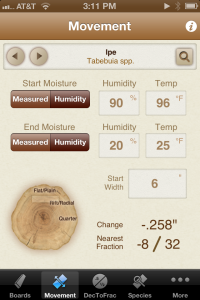
Each decking species will have different movement properties, but let’s use Ipe as an example. If we install a typical 1×6 Ipe decking board today using our weather conditions of 90% humidity and 96°, it will maintain that width through the heat and humidity; however, as we draw into the fall season, both the heat and humidity begin to drop. If we pick a day in early October and assume 50% humidity and 65°, then the Ipe decking will have shrunk approximately 3/16 of an inch. Now your starting 1/4″ decking gap is almost a half inch wide! You dinner guest just got their heel stuck on your deck at that swanky dinner party.
Winter is coming
Fast forward to the dead of winter, and the temperature is now 25° with the humidity around 25-30%. Your decking has now shrunk another couple of 16ths of an inch, and that half inch decking gap is closer to 5/8″. Now your Chihuahua just fell through the gap between the deck boards!
That widening gap will make any deck owner upset. Now let’s imagine the opposite scenario where the deck was installed with a 1/4″ gap in the dead of winter. By summer time those boards have expanded by more than 1/4″. In a perfect world we can assume even expansion in both direction. Therefore each board would swell 1/8″ on both sides. If you are lucky, that original 1/4″ gap is gone. In reality, boards don’t always expand evenly, and it will vary depending on where the board was located within the original log. Usually the boards expand beyond that 1/4″ gap. Now the boards are buckling and possibly cracking since they have no place to go. This results in serious damage and the need to replace decking.
Just to make things even more difficult, wood is anisotropic. Wood moves differently in each direction based on how the wood was cut. Quartersawn boards barely move across the width whereas flatsawn boards will move the most. The examples above use flatsawn boards since this is most common. Now not only will the gap change, but it may not change consistently across the entire deck.
Choosing Deck Spacing Between Boards
What is the solution you ask? How to stop the madness? You can’t stop it. Wood moves, get over it. Embrace it and plan the gap between that decking accordingly.
In the above scenario where I installed the deck in the summer, I could install it with very little gap. In the winter I would end up with a typical 1/4″ gap. You still want a little gap just to let rainwater drain through. With no drainage comes standing water and a whole new set of movement issues.
If the deck is installed in the winter, then you definitely need that 1/4″ gap. In the humid climates you might want to bump that out a 32nd or a 16th of an inch for insurance. So when your customer answers your “when” question and tells you they want a 1/4″ gap in May. Then you need to run some numbers and figure out just how much that decking is going to expand and contract throughout the year.
The screenshots pictured here come from The Woodshop Widget, and it is a really handy app for the web or your phone that can save you a lot of heartache.
Deck Board Spacing in a Dry Climate
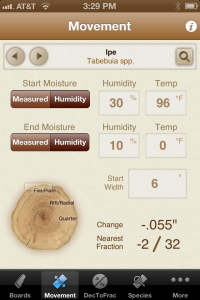
Guess what? You guys are the lucky ones, and not just because you don’t have to swim through the air in the summer or worry about your ice tea leaving a ring on your grandmother’s Chippendale furniture.
Wood movement is driven by moisture primarily and not so much by temperature. Certainly the warmer the air is, the more water it can hold, but that is a relative number. If you look at the image to the left you can see the extreme scenario of installing an Ipe deck in the heat of summer and looking at a movement of only 1/8″ compared with a typical winter day in say, Denver, CO. A 70° difference means almost nothing to the wood and that 1/8″ movement is driven by the humidity drop. Now you can get away with that 1/4″ gap in the winter, and you will find that it remains very close to the same throughout much of the year.
Next time you begin a deck installation (or any woodworking project), take a moment to think about the potential humidity and temperature change throughout the year and what kind of sun and rain exposure the lumber will face. Wood movement percentages are published on our web site on every species page to help you determine just how much movement you could face. Or if you are lazy like me, you can just find an app for that.
Learn more about the lumber industry:

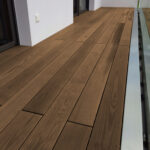
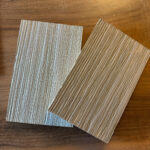

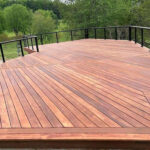
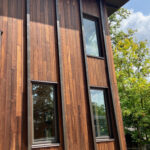



Leave a Reply